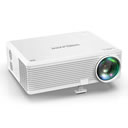General Questions
What’s the difference between LED, LCD or DLP?
DLP, LCD and LED are three main technologies used for projection. DLP (Digital Light Processing) uses a chip made of tiny microscopic mirrors and a spinning colour wheel to create an image. DLP projectors deliver sharp images, don't need any filters, have a better response time as well as 3D capabilities. The effective lamp life of a DLP projector is only 2,000-5,000 hours.
On the other hand, LCD projectors use liquid crystal displays, have no moving parts and thus are generally less expensive. If you are on a budget a single chip LCD projector is ideal. Most LCD projectors come with long-lasting lamp and the lifespan can reach 50,000 hours, that’s much longer and cost-effective than DLP projector.
LED projectors are smaller and generate less heat. Do keep in mind that LED projectors have limited brightness compared to LCD or DLP so they are not recommended if your room has a lot of ambient light.


